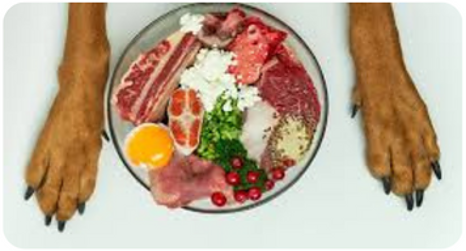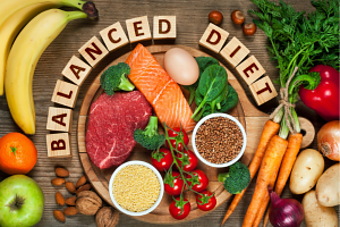
Ever wonder what our canine companions ate before commercial kibble found its way into their food bowls? Well, if you’re curious, that’s precisely what the raw food diet for dogs aims to replicate – their ancestral diet.
The basic idea behind this diet is simple: feed dogs what they naturally ate before they became our best friends. This isn’t just about tossing your dog a bone; it’s also about providing a balanced mix of meat, bones, organs, and sometimes fruits, vegetables, and supplements, mimicking what their wild relatives eat.
Interest in the raw food diet for dogs has been growing, with many advocates claiming it’s more in tune with a dog’s biological needs. Pet owners today are more informed and conscientious about their dogs’ dietary needs, looking for alternatives to processed dog foods.
Now, I’m not here to sell you on this diet right off the bat. I’m here to help you understand what it entails and why some swear by it. In the next section, we’ll dig into the details of the nutritional composition and the different varieties of raw diets you can serve up to your furry friend.
The Nutritional Composition and Varieties of Raw Dog Food

When you’re considering a raw diet for your furry friend, it’s crucial to understand the components of a nutritionally balanced meal. Just as with humans, dogs require a mixture of proteins, fats, carbohydrates, vitamins, and minerals to thrive. A raw diet typically consists of muscle meat, often still on the bone, organ meats like liver and kidneys, raw eggs, vegetables like broccoli and spinach, and sometimes dairy, such as yogurt or cottage cheese.
There’s a spectrum of raw diets available for dogs, each with its followers and philosophy. The Biologically Appropriate Raw Food (BARF) diet, for example, includes fruits and vegetables, considering them vital for their fiber content and natural enzymes. On the other hand, the Prey Model raw diet sticks closely to the types of foods dogs would eat in the wild, consisting primarily of meat, bones, and organs, with no plant material.
For those who prefer to prepare meals at home, the DIY raw feeding route allows total control over the ingredients and sourcing. However, this approach requires a sound understanding of canine nutritional needs to avoid deficiencies or excesses. Alternatively, the market is rich with commercial options that offer the convenience of pre-formulated raw meals, ensuring balanced nutrition that meets recognized standards without the guesswork.
Moreover, you’re going to find out about commercial raw food offerings that cater to various needs, including freeze-dried options, frozen raw patties, and even dehydrated raw foods. This variety affords dog owners the flexibility to choose what resonates with them and their pet’s lifestyle. Just keep in mind the importance of gradually transitioning your dog to a new diet to prevent digestive upset.
Exploring Popular Brands of Raw Dog Food

Now, I’m going to guide you through some of the recognized brands in the raw dog food market. You can’t just pick any brand; it has to fit your dog’s specific needs and you also want to ensure you’re getting top-notch quality.
When you’re browsing the shelves or scrolling online, consider these major factors: ingredient quality, nutritional balance, price, and availability. Your dog’s health isn’t something to take lightly, so do your research and talk with your vet to ensure you are choosing the best food for your pup.
Choose something that resonates with you, but more importantly, something that’s good for your furry friend. Here’s a peek at a few brands known for their raw dog food:
“As an Amazon Affiliate, I may earn a small percentage from qualifying purchases, which will not change your price at all.”
– Primal Pet Foods: Utilizes human-grade ingredients, and offers both frozen and freeze-dried options.
– Stella & Chewy’s: Known for their variety, including dinner patties and morsels that entice even the pickiest eaters.
– Orijen: They provide freeze-dried foods and claim to use ingredients that are sustainably farmed or fished.
– Nature’s Variety Instinct: Their options cater to different dietary needs, with grain-free recipes and high-protein formulas.
– BARF World: Stands for Biologically Appropriate Raw Food, and they deliver exactly that with their subscription service.
Remember, transitioning to a new diet isn’t instantaneous, and you might need to experiment to land on the brand and type that your dog thrives on.
Alright, with those names in your back pocket, let’s weigh the potential benefits against the downsides in the next section.
The Pros and Cons of a Raw Food Diet for Your Dog

I’m going to cut straight to the chase: choosing a raw food diet for your dog can have both substantial benefits and notable risks. You want what’s best for your furry friend, and that means understanding all sides of the story.
On the plus side, proponents argue that a raw diet is closer to what dogs would eat in the wild. They believe it can lead to shinier coats, healthier skin, higher energy levels, and cleaner teeth. There’s also the thought that it could decrease allergy symptoms and improve overall digestion.
However, raw diets come with their fair share of warnings. The risk of bacterial contamination like Salmonella or E. coli is something to take seriously. Plus, ensuring a nutritionally balanced diet requires meticulous planning – it’s not just about tossing your dog a raw steak and calling it a day.

Veterinarians warn that an imbalanced diet could lead to nutritional deficiencies or excesses over time, which might not be immediately apparent. Young pups, in particular, have specific nutritional needs that are vital for their development.
Now, if you’re seriously considering the raw diet path, consulting your vet is a non-negotiable step. They know your dog and can provide personalized advice. You can always adjust your approach down the road based on how your dog responds and new research findings.
Remember, each dog is unique, and there’s no one-size-fits-all solution. Choose something that resonates with you, aligns with your capacity for meal preparation, and fits your dog’s health profile. Security in your choice comes from arming yourself with knowledge and making an informed decision.
We hope this helps if you’re curious about raw dog food diets. And as always, feel free to leave any comments or questions.
